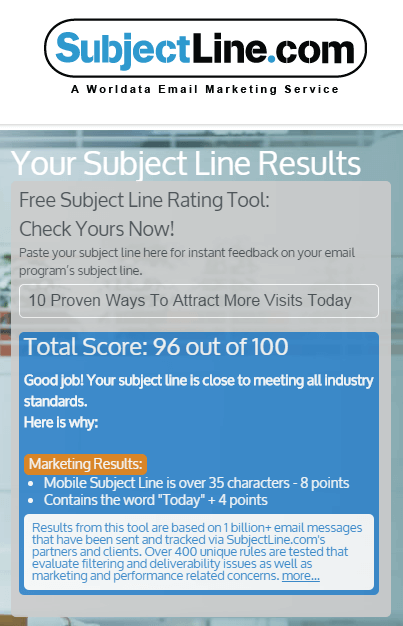Even though the subject line is a small part of an email, it is the first impression you have on your recipients. If the email subject line doesn’t catch their attention, you won’t go any further.
Subject line writing has truly evolved over the years. Today, people need quick and easily digestible content. With the overwhelming amount of content online trying to get people’s attention, a good subject line can make or break your email content.
Some interesting numbers for you from Neil Patel:
- 8 out of 10 people will read headline copy
- But only 2 out of 10 will read the rest
- A writer should spend half the entire time it takes to write a piece of persuasive content on the headline
We all know that writing email subject lines is not an exact science. There are so many factors that can affect your open rates. Below are 15 tips on crafting a click-worthy email subject line that will increase the number of people who will actually read your email.
Let’s begin!
Tip #1: KISS – Keep it Short and Straightforward
Most people quickly scan subject lines to decide if they’ll open or ignore the email. Keep your subject line to 50 characters or less. Some fun facts:
- People scan headlines – take in only the first and last 3 words
- Less to read so higher chance of retaining attention
I would go on and recommend to write concise and no nonsense email subject lines. If you’re email has a specific purpose then your subject lines should be specific as well. Be careful not to go overboard with promotional and cheesy phrases.
Tip #2: Give it a sense of urgency
Using deadlines like “5 Hours Only” or “24 Hour Giveaway” will encourage your reader to act now, instead of putting it off until later – when there’s a chance of them forgetting it. Email subject lines that use this scarcity appeal compel people to act or make a decision because of that inherent fear of missing out. This is a particular human behavior most evident back in the days where people were always on survival mode. Hang on, on second thought, that’s also evident in today’s times.
A word of caution in using this scarcity appeal, make sure what you’re offering in your email is something that your recipients care about, otherwise, the time and availability limitation would be irrelevant to them.
Tip #3: Appeal to your audience’s interests
Tailor the subject lines to connect on a more personal level with your target audience. This is pretty much one of the guiding principles of online marketing. By knowing your audience, you can cater to their specific needs and tickle their fancies with the right style and tone in your subject lines.
For example, let’s say you have two primary segments in your e-mail list – Marketing Managers and Business Owners. Each segment has different goals, interests and challenges. When you send out emails to them, make sure you use different subject lines that best appeal to their interests or address their challenges.
Marketing Managers are interested more in how-to guides and specific tactics, while Business Owners are interested more in the end result – the ROI. Here are two different subject lines that show this concept:
Marketing Manager: “Five ways to improve e-mail open rates by writing better subject lines”
Business Owner: “Improve e-mail marketing ROI by understanding how subject lines affect e-mail engagement”
Tip #4: Use Personalization
It’s said that a person’s favorite word is their own name. By adding the recipient’s name, you you make the the person feel connected to your business. It’s a good way to start building the relationship. Say something like this: “Hi David, don’t miss out on our latest analytics update…”
Additional tip, if you’re not comfortable using names, use “you” or “your”. This gives them a feeling of being addressed directly.
Tip #5: Use Localization
You don’t have to end with incorporating the recipient’s name into the subject line. You can try personalizing a message with location-specific offers and language. MailChimp research suggests including a city name is even better.
If you’re an eCommerce business, sending emails that promote discounts and deals based on the recipient’s local area or based on past purchases would be a great way to attract more opens. Generally, it’s always good practice to know and understand your target audience to be able to use the right language and offers that best resonates with them.
Tip #6: Don’t make false promises
You don’t want people clicking on ‘Unsubcribe’, right? Best way to do this is to deliver on your promise in your subject line.
For example, you created an email workflow for people who download files from your website. If you email subject line says, ‘”You’re download is ready”, better make sure there is a clickable link inside where they can access what they downloaded from your website. Sounds pretty standard right? But there are still some who make false promises just to get their emails opened. Tsk… tsk.
Additional tip, say something along the lines of, “Access your case study now”, instead of a generic “Thank you”. This goes back to being concise (Tip#1); make it clear that something is inside the email waiting to be accessed.
Tip #7: Consider how your recipients will benefit from your email
Make it clear how your email will benefit your recipient. Given that you’ve done your homework of understanding your target audience – interests, goals and challenges, write a subject line that best communicates the value of your email to them. Below is an email I received from Quick Sprout that illustrates my point.
Tip #8: Use Questions
Asking a question in your email subject line can also draw your recipients in. These types of subject lines arouse a sense of curiosity to know more about the subject and see whether it applies to them. By asking questions, you engage with your recipients in an instant dialogue and make them more likely to open your email.
Possible questions:
- Are your landing pages converting?
- Is your website providing the best user experience?
Tip #9: Use numbers and lists
People just love numbered lists. Similar to using questions, these types of subject lines make your emails stand out and create curiosity. Email subject lines with numbered lists make your recipients feel that the content of your email is a quick and easy read.
Tip #10: A/B testing
Heard this a million times? Improving e-mail subject lines is a process of testing and optimizing. I can’t emphasize this enough. A/B test everything, especially your email subject lines.
Tip #11: Avoid spam words
Avoid words like- Free, Bonus, Discount, % OFF, because they trigger spam filters. These words are way overused and commonly associated with sales pitches. Though some may not trigger a spam filter, many recipients will choose to ignore them.
Tip #12: Don’t overuse capitalization
More caps does not equal more email opens. Best to capitalize your letters following grammar rules.
Tip #13: Use free subject line testing tools
Most email marketing systems have their own built-in tool for testing subject lines. SubjectLine.com is helpful when it comes to testing your subject lines. It’s a free subject line rating tool. Simply type in your subject line and click submit. You’ll get a rating for your email subject lines and a breakdown of the results. Below is an example of a subject line I tested.
Tip #14: Emoji or not to emoji?
Using symbols or emoji in subject lines isn’t a new idea. However, now that many of us have emoji-friendly mobile devices and regularly read our email on them, it’s become an increasingly popular tactic for attracting attention in crowded inboxes.
Word of caution though, if a character isn’t supported in the email provider of the client, the recipient will see a ☐ (empty box) character instead of the actual emoji or symbol.
Try using emojis and symbols in your next email subject line and test! Sometimes images are better than words in grabbing people’s attention.
Tip #15: Add preview texts
Preview texts provide your recipients a glimpse of your email content. Don’t underestimate the preview texts’ power to improve your open rates. Treat them the same way you treat your subject line. Below is an example preview text from one of our newsletters here at FIRST.
Tip #16: Use negative words
In his Infographic, Neil Patel notes that negatives tap into our insecurities. The words “No”, “Without” and “Stop” lead to more shares.
Conclusion
As I mentioned in the beginning of the post, there are several factors that can affect your open rates. Other factors could be:
- Email list segmentation – have you properly qualified and segmented your email contacts database?
- Sending frequency – how often are you sending emails? Make sure you’re not being too annoying.
- Sending time and day – are you sending your emails on the best time and day of the week? That would depend on your target audience’s time zone, industry and background. Check this post on the best time to send email newsletters to get an idea.
- Purpose for sending – do you have a clear grasp of why you are sending out emails? In the case of a newsletter, does you business even need one? Find out the why before the how.
As more and more content is created everyday, each piece trying to grab your audience’s attention, combat this noise by making your subject lines brief, concise and interesting to your audience. You might not come up with the perfect subject line straight away. It will take ongoing A/B testing to find out what works best for your unique audience. As you get a better understanding of what works, you can optimize your subject lines for better performance.



